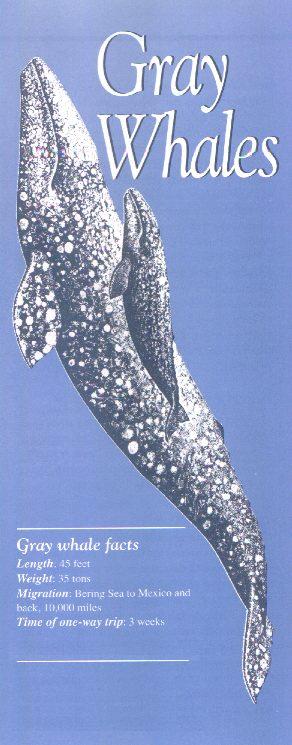A huge creature the size of a city bus emerges from the rolling
waves and with a loud swoosh, exhales a steamy breath of air. It's
a gray whale making one of the most remarkable migrations in the natural
world, a scene which can be observed each winter along the Northwest coast.
Each winter, more than 20,000 gray whales can be observed along
the Northwest coast as they make their way south on part of their incredible
12,000 mile annual round trip migration from the northern waters off Alaska
and the Arctic Sea to their winter breeding grounds of Baja California
off Mexico.
The lucky whale watcher who catches the peak of the migration can watch
spout after spout as the near offshore waters become a whale highway.
Mid-December through early January is typically the peak of the migration
with as many as 30 whales per hour passing the coast.
Watching whales from shore is best from a high vantage point (such
as Cape Kiwanda) on a calm day. Whales are spotted by watching for their
spout as they surface. When a whale surfaces, it exhales a burst
of water and vapor up to 12 feet in the air. If the ocean is too
rough, it's difficult to tell a whale from a breaking wave. (Another great
location for viewing is nearby Cape Lookout)
Once a spout is spotted, focus with binoculars slightly ahead to watch
them surface again. Gray whales typically exhale three to five times,
less than a minute apart, before diving for five to ten minutes.
Mothers with calves are often easiest to spot because they move more slowly
and stay closer to shore. Once you've got the hang of it, it becomes easier
to spot the giant 35 ton creatures.
Rarely will you see more than the spout and the back of the whale roll
out of the water. If the whale is preparing for a deep dive, you
may see it's tail come out of the water. Occasionally, gray whales
will breach, coming head first out of the water as much as three quarters
of their length before splashing back on their sides. They may also be
seen raising their head and eye out of the water for as long as 30 seconds
in a behavior known as "spy-hopping".
If you miss the winter migration, you won't have to wait long for
another opportunity. Upon reaching their wintering grounds in the warm
waters off Mexico, the gray whales breed or give birth, and by March they
begin their return to the north along with their newborn calves, just a
few months old.
|
|
